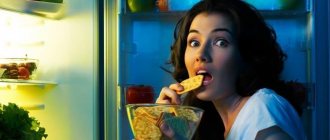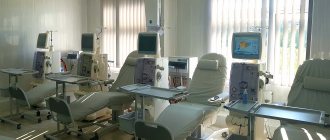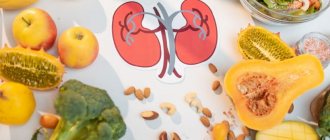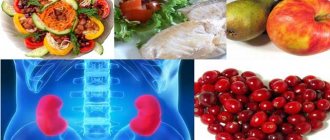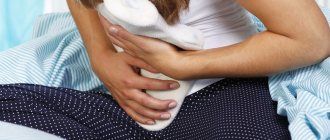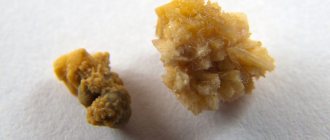General description of the disease
Cystitis is an inflammatory disease of the bladder that can occur together with inflammation of the urethra (urethritis).
Causes of cystitis
Cystitis is caused by various bacteria that enter the urinary tract through the urethra. Typically, this pathogen may be Escherichia coli, which is normally found in the rectum.
Also, cystitis can be provoked by prolonged sexual intercourse during which the opening of the urethra is irritated (the first symptoms occur within 12 hours after sexual intercourse), urinary retention or an incompletely emptied bladder (most often observed in disabled or elderly people). In addition, some people may be allergic to perfumed soaps, vaginal deodorants, talc or colored toilet paper, which can trigger the development of cystitis. The cause of cystitis in children can be deviations in the anatomical structure, in which urine is “thrown back” into the ureters.
Symptoms of cystitis
Symptoms of cystitis include the following: painful (with a burning sensation) and frequent urination, pain in the lower back or lower abdomen, urine with a strong odor, cloudy appearance and inclusions of blood. Children and older people may experience fever, nausea, and abdominal pain.
Types of cystitis:
- acute cystitis;
- chronic cystitis.
General principles of diet
A diet for cystitis is absolutely necessary. But this should not just be a balanced and nutritious diet, but the most gentle diet aimed at eliminating inflammation and improving urine flow. It is recommended to remove from the diet all irritating foods containing large amounts of essential oils and acids.
It is also necessary to observe the principle of fractional nutrition - eat food 4-5 times a day, in small portions, and drink more in between meals.
It is especially important to adhere to a diet during exacerbation of cystitis. In this case, a properly selected diet will reduce intoxication of the body, slow down the development of bacteria and prevent the disease from becoming chronic. If the worst does happen and the disease is already advanced, the diet will prevent exacerbation and reduce the frequency of relapses.
To get the maximum therapeutic effect from the diet, food for cystitis should be boiled, stewed or baked. Fried, pickled and smoked foods will only worsen the condition.
Poor intimate hygiene
You should only wash yourself and use toilet paper using movements that go from front to back, and in no case vice versa. Otherwise, the bacteria contained in the stool will end up on the genitals.
For the same reason, it is very important to maintain good hygiene during sexual intercourse. Before and after intimacy, you must visit the toilet and bathroom. You need to treat yourself especially carefully during menstruation, since during this period the body is weakened and therefore especially vulnerable to infection. Change tampons at least every two hours, use only pads at night.
Authorized Products
What can sick people eat and drink? In general, the range of acceptable and healthy dishes for cystitis is quite wide. The list includes:
- vegetables and fruits;
- fresh herbs from the garden;
- fermented milk products;
- cereals;
- lean meat and fish, chicken;
- berries (especially lingonberries and cranberries);
- dried fruits and nuts;
- vegetable oils and animal fats.
It is very useful to eat fresh, uncandied honey for cystitis. The delicacy has excellent antimicrobial and antiseptic activity, cleanses the urinary tract, and destroys pathogens.
As for drinks, it is allowed to include green tea and mineral waters in the diet. Pumpkin, carrot and apricot juices are very useful for cystitis. They can be consumed individually or mixed into a cocktail.
Prohibited Products
You should remove from your diet all foods that can cause urinary tract irritation, pain and inflammation. These include all kinds of spices, seasonings, marinades, pickles and smoking. But this is not the entire list of foods excluded for cystitis.
What else patients should not drink or eat:
- canned food;
- strong broths;
- pickled vegetables, legumes, green and onions, turnips, rhubarb, horseradish;
- citrus;
- alcoholic drinks, beer, black tea and coffee;
- sugar, confectionery.
Women should remove pork, meat from young animals, store-bought convenience foods, various sauces and ketchups from their diet. Also, for cystitis, it is recommended to reduce the amount of table salt and give up chocolate and cocoa.
How not to cause harm
It is impossible to harm yourself using this incredible vegetable. A few tips about restrictions and admission rules will help you avoid unpleasant moments. You should not drink the squeezed juice straight away. It contains volatile substances that can cause nausea, dizziness, and general weakness. The drink should stand in the refrigerator for a couple of hours.
Restrictions on the use of the product relate to several diseases:
- stones in the kidneys;
- diarrhea;
- diabetes mellitus II degree;
- osteoporosis.
Diet features
In addition to general recommendations for following a diet during cystitis, there are also separate instructions that allow you to normalize the patient’s condition in case of aggravation or chronic course of the disease.
For acute cystitis
The acute phase of cystitis lasts 5–7 days. In this case, the woman experiences significant discomfort, accompanied by pain and frequent urge to urinate. To get rid of painful symptoms, the diet during such a period should contain more dishes with a diuretic and antimicrobial effect.
So, what can and should be eaten in acute cystitis:
- Lingonberries and cranberries. They make healthy drinks or eat them straight, mashed and mixed with honey.
- Watermelons, cucumbers, watercress, melon, carrots, pumpkin. These vegetables improve the flow of urine and cleanse the excretory tract without disturbing the water-salt balance.
- Fruits you can include in your diet include apples, pears, and pomegranate seeds.
- Lean beef or white meat.
- Fermented milk products, cottage cheese. When choosing cheeses, you should choose unsalted varieties.
- Cereals, bran.
- Vegetable, cow oil.
Among drinks for acute cystitis, calcium chloride and sodium waters give a good therapeutic effect (Izhevskaya, Essentuki No. 17, 4, Mirgorodskaya). They are included in the diet for the entire period of treatment and taken 10–15 minutes before meals.
The diet can be adjusted after testing. If phosphate or oxalate salts are detected in the urine, the patient is advised to follow treatment table No. 14 or No. 6, respectively. If signs of uric acid are detected in a woman with acute cystitis, purine-containing foods are removed from the diet.
The appearance of calcium salts in urine indicates a strong alkalization of the body. In this case, all dairy products are removed from the diet, replacing them with protein products. Unsaturated meat and fish broths are allowed. For hemorrhagic cystitis, the diet includes dishes that reduce bleeding of the mucous membrane: boiled white meat, non-acidic vegetables and fruits, freshwater fish.
For chronic cystitis
If acute cystitis is not treated, it will soon become chronic. With this form of the disease, the diet becomes stricter and the list of prohibited foods expands. Marinades, spicy and pickled foods, seasonings and spices are permanently removed from the diet. Limit the consumption of irritating vegetables. Read more about chronic cystitis →
Prohibited foods for chronic cystitis:
- smoked, fried and canned foods;
- ready-made semi-finished products, fast foods, food with dyes, flavors and other harmful additives;
- margarine, cooking oil, lard;
- any alcohol, kvass, carbonated water;
- sugar, chocolate, baking.
It is clear that it is unlikely that you will be able to completely remove prohibited foods from your diet, but you need to stop using them at least if cystitis worsens.
What other foods should patients with long-term inflammation not eat? For patients who are constantly plagued by discomfort in the urinary tract and urinary disorders, it is better to give up citrus fruits, sour fruits, and grapes.
Preference should be given to boiled or baked foods with a neutral taste. In the chronic form of cystitis in women, it is useful to include more fiber, whole grains, wheat bran, lactic acid products in the diet, and regularly take diuretic and anti-inflammatory preparations.
Principles of diet therapy for diseases of the kidneys and urinary tract
- Diet diversity, adequacy of macro- and micronutrient composition and energy value of the diet to the dynamics and severity of kidney and urinary tract disease.
- At all stages of treatment (inpatient, sanatorium, outpatient), dietary therapy should be differentiated depending on the nature and severity of kidney and urinary tract disease, the presence of complications and concomitant diseases.
- Individualization of the chemical composition of the diet due to the inclusion in the diet of dietary (therapeutic and preventive) food products, as well as specialized food products - dry protein composite mixtures (PCPS). The possibility of using a specific protein composite dry mixture in dietary medical nutrition as a component in the preparation of ready-made meals must be confirmed by the results of relevant studies of its clinical effectiveness in a medical research institution certified to conduct such tests. As a rule, such studies are carried out at the Clinic of the Federal State Budgetary Institution Research Institute of Nutrition of the Russian Academy of Medical Sciences.
When preparing food, patients with kidney and urinary tract diseases should follow several important rules: remove extractive substances from foods that are rich in them, do not use canned foods, smoked meats, pickles, table salt, fry foods only after preliminary boiling.
Basic principles of diet therapy
Glomerular diseases
The diet of patients with glomerular diseases is aimed at reducing edema syndrome, azotemia and lowering blood pressure.
The diet for this category of patients should be divided and include 4–6 meals a day.
In the first 2–3 days of the disease, a diet with a low sodium content is prescribed in the form of contrast days (potato, watermelon, banana, apple, pumpkin, etc.). Subsequently, a diet with a slight protein restriction of up to 70 g/day is prescribed. Protein is introduced into the diet of patients mainly through the protein of eggs, milk, and fish, which contain fewer extractive substances. The exception is patients with nephrotic syndrome, who require compensation for protein loss. They can be prescribed a diet with a normal and increased amount of protein or the diet can be adjusted individually with the inclusion of specialized food products, mixtures of dry protein composites in a volume of 27 g (the norm of therapeutic nutrition when following a standard diet in accordance with Order of the Ministry of Health of Russia dated June 21, 2013 No. 395n “On approval of norms for therapeutic nutrition”) up to 36 g (norm for therapeutic nutrition when following a diet with a high amount of protein) of the mixture as part of a daily set of products. For example, when using SBCS "Diso®" "Nutrinor", containing 40 g of protein per 100 g of product, the patient will receive from 10.8 to 14.4 g of protein with high biological value.
It is recommended that patients with glomerular diseases consume fats and carbohydrates in quantities corresponding to the physiological norm. Table salt must be excluded. Limit fluid to 0.8 liters (the amount of fluid is determined by the amount of daily diuresis + 500 ml), exclude extractive substances. It is also necessary to limit simple carbohydrates to 50 g per day and exclude alcohol, strong coffee, tea, cocoa, and chocolate.
Urolithiasis disease
For patients with urolithiasis, a split diet is recommended, including 4–6 meals a day. The amount of free liquid in the diet increases to 2 liters per day.
The calorie content of the diet, the amount of proteins, fats and carbohydrates in the diet of this category of patients must correspond to the physiological needs in accordance with age, gender, the nature of physical activity and nutritional standards approved by Order of the Ministry of Health of Russia dated June 21, 2013 No. 395n “On approval of therapeutic nutrition standards.” The norms of therapeutic nutrition are applied when following a diet with a reduced amount of protein (low-protein diet) with the inclusion of specialized food products, mixtures of dry protein composites in the volume of 18 g of the mixture (for example, when using SBKS "Diso®" "Nutrinor" - 7.2 g of protein) in composition of the daily set of products.
Patients need to limit their intake of table salt to 3–5 g/day.
With uraturia, foods containing purine bases are sharply limited. Description of the diet: complete in calories, limited in fats of animal origin, slightly reduced amount of protein to 70–80 g/day, rich in alkaline valences. By-products (liver, kidneys, tongue, brains), meat of young animals (chickens, veal) are excluded from food. Fatty meats and fish, meat and fish broths are prohibited. Meat and fish dishes are served only boiled. Exclude legumes rich in purines (peas, beans, beans, lentils, as well as sorrel and spinach). Protein correction is carried out in accordance with the norms of therapeutic nutrition while following a diet with a reduced amount of protein.
In case of oxalaturia, foods with excess content of oxalic acid and its salt are excluded from the diet: sorrel, spinach, beets, beans, rhubarb, figs, parsley, plums, strawberries, gooseberries, tea, cocoa, chocolate, and gelatin. In order to alkalize the body and eliminate potassium and magnesium deficiency, a large amount of unsweetened fruits and dried fruits (pears, prunes, dried apricots) is introduced. Limit dishes from meat, fish, poultry (up to 150 g every other day); during an exacerbation, limit dairy products due to the high calcium content. Protein correction is carried out in accordance with the norms of therapeutic nutrition while following a diet with a reduced amount of protein.
With phosphaturia, diet therapy is aimed mainly at acidifying urine and limiting foods rich in calcium salts and containing alkaline valences. Protein should mainly come from meat foods, dairy and plant foods are limited. Greens and vegetables you can include in your diet include peas, Brussels sprouts, pumpkin, and asparagus. Berries: sour apples, lingonberries, red currants. Protein correction is carried out in accordance with the norms of therapeutic nutrition while following a diet with a reduced amount of protein.
Want more new information on nutrition issues? Subscribe to the informational and practical magazine “Practical Dietetics”!
SUBSCRIBE
Chronic renal failure
Patients with chronic renal failure should follow a split diet, including 4–6 meals a day.
It is necessary to limit protein intake from food to 20, 40 or 60 g per day, depending on the severity of renal failure (0.6–1.0 g/kg body weight). And also provide the body with the minimum required amount of essential amino acids by introducing complete animal protein into the diet (limit vegetable protein).
The amount of fats and carbohydrates consumed should be calculated to ensure sufficient energy value of the diet corresponding to the body's energy expenditure (approximately 35 kcal/kg body weight per day).
The diet of patients with chronic renal failure includes foods that contain a small amount of protein and are high in calories (various sago dishes, protein-free bread made from maize and wheat starch, purees and mousses with swelling starch). The patient's diet is provided with vitamins, macro- and microelements. Protein correction is carried out in accordance with the norms of therapeutic nutrition while following a diet with a reduced amount of protein.
The menu of a sick person is compiled taking into account the required amount of vitamins, macro- and microelements. The amount of salt and water is limited to a level that ensures the maintenance of normal water and electrolyte composition of the body’s internal media. Salt is not used when cooking food.
Depending on the level of disturbance of the electrolyte composition of the blood, it is necessary to limit the consumption of foods high in potassium (apricots, raisins, potatoes) (1500–2000 mg of potassium per day), phosphates to 600–1000 mg/day (dairy products), magnesium (cereals, legumes, bran, fish, cottage cheese). You should also limit the amount of nitrogenous extractives in the patient’s diet, reduce the consumption of alcohol, strong coffee, tea, cocoa, and chocolate.
Chronic renal failure (hemodialysis or peritoneal dialysis)
Nutritional treatment of patients with chronic renal failure on hemodialysis or peritoneal dialysis is carried out to prevent or treat malnutrition, reduce the accumulation of fluid, metabolites, potassium and phosphorus and prevent complications of uremia (damage to the cardiovascular system, osteopathy, etc.). The nutrient requirements of this category of patients are shown in Table. 1. When prescribing a diet, special attention should be paid to potassium, phosphorus and fluids.
Table 1. Daily nutrient requirements of patients with chronic renal failure undergoing hemodialysis and peritoneal dialysis
| Indicators | Hemodialysis | Peritoneal dialysis |
| Energy, kcal/kg | > 35 | > 35 |
| Protein, g/kg | 1,1–1,4 | 1,2–1,5 |
| Phosphorus, mg | 800–1000 | 800–1000 |
| Potassium, mg | 2000–2500 | 2000–2500 |
| Sodium, mg | 1,8–2,5 | 1,8–2,5 |
| Liquid, ml | 1000 + daily urine output | 1000 + ultrafiltrate + daily diuresis |
Patients are recommended to eat a split diet, including 4–6 meals a day. Adequate caloric and protein intakes should be maintained during dietary treatment. Patients are recommended diets with increased amounts of protein, since with each session of dialysis therapy they lose amino acids and protein, 8–9 g with chronic ambulatory peritoneal dialysis and 10–13 g with hemodialysis.
The calorie content of the diet, the amount of proteins, fats and carbohydrates in the diet must correspond to physiological needs in accordance with age, gender, the nature of physical activity and nutritional standards approved by Order of the Ministry of Health of Russia dated June 21, 2013 No. 395n “On approval of therapeutic nutrition standards.” The norms of therapeutic nutrition are applied when following a diet with an increased amount of protein (high-protein diet) with the inclusion of specialized food products, protein composite dry mixtures in a volume of 36 g of the mixture as part of a daily set of products. Protein correction is carried out in accordance with the norms of medical nutrition, for example, when using SBCS "Diso®" "Nutrinor", containing 40 g of protein per 100 g of product, the patient will receive 14.4 g of protein with high biological value.
The amount of salt and water is limited to a level that ensures the maintenance of the normal water and electrolyte composition of the internal environments of the body. The amount of fluid consumed is calculated individually, depending on daily diuresis and the amount of ultrafiltrate during peritoneal dialysis. Salt is not used when cooking food.
Depending on the level of disturbance of the electrolyte composition of the blood, it is necessary to limit foods with a high potassium content (apricots, raisins, potatoes) (2000–2500 mg of potassium per day), phosphates to 800–1000 mg/day (dairy products).
The diet of patients should be enriched with vitamins and microelements. Due to losses associated with dialysis, their need for water-soluble vitamins increases.
As with other diseases of the kidneys and urinary tract, patients with chronic renal failure on hemodialysis or peritoneal dialysis should limit the amount of nitrogenous extractives in the diet, alcohol, strong coffee, tea, cocoa, and chocolate.
Parenteral and enteral nutrition is usually prescribed to patients with the acute phase of the disease.
Sample menu for the week
Guided by the list of permitted and healthy dishes for cystitis, you can independently create a treatment menu. It’s better to prepare it for a week at once - it’s more convenient to purchase the necessary products and calculate the nutritional value of the diet.
You should try to include a sufficient amount of light protein-containing dishes (1.0–1.5 g of protein per 1 kg of weight) and vegetables in your diet. As for fats, it is not advisable to either overload the diet with them or exclude them. This is the most important building material for endocrine organs in women, but it is better to remove coarse fats from the menu.
Therapeutic diet for cystitis for a week.
Monday
| Breakfast | Rice porridge with butter, meat cheese, tea with milk |
| Lunch | Fresh apples, juice |
| Dinner | Noodle soup with chicken broth, quenelles with mashed potatoes, compote |
| Afternoon snack | White crackers, rosehip infusion |
| Dinner | Carrot zrazy with cottage cheese, apple pie, lingonberry leaf decoction |
Tuesday
| Breakfast | Buckwheat porridge, chicken breast, tea with milk |
| Lunch | Curd pudding, glass of kefir |
| Dinner | Borscht with sour cream, boiled potatoes, beef stroganoff, fruit jelly |
| Afternoon snack | Biscuits, watermelon, juice |
| Dinner | Boiled fish with vegetables, green tea |
Wednesday
| Breakfast | Semolina porridge, steam omelette, cow butter, milk tea |
| Lunch | Carrot, cucumber and cabbage salad, juice |
| Dinner | Milk soup with noodles, boiled chicken in white sauce with vegetables, compote |
| Afternoon snack | Cranberry jelly, crackers, rosehip infusion |
| Dinner | Rice pilaf with fruit, cheesecake with cottage cheese, decoction of lingonberry leaves |
Thursday
| Breakfast | Oatmeal, cheese, weak coffee with cream |
| Lunch | Grated carrots with sour cream, juice |
| Dinner | Potato soup, baked meat, zucchini stewed in cream, berry jelly |
| Afternoon snack | Fresh cucumber salad, glass of kefir |
| Dinner | Stewed potatoes with meat, green tea |
Friday
| Breakfast | Fresh vegetable salad, buckwheat porridge with butter, tea with milk |
| Lunch | Cottage cheese casserole, juice |
| Dinner | Barley soup with meat broth, meatballs, beets stewed in sour cream, compote |
| Afternoon snack | Melon, steam omelette, glass of curdled milk |
| Dinner | Carrot-apple balls with cranberry sauce, decoction of lingonberry leaves |
Saturday
| Breakfast | Krupenik with cottage cheese, cracker pudding, tea with milk |
| Lunch | Cucumber salad, juice |
| Dinner | Rassolnik, pilaf with meat, fruit jelly |
| Afternoon snack | Biscuits, watermelon, rosehip infusion |
| Dinner | Potato souffle, jellied pike perch, green tea |
Sunday
| Breakfast | Fresh vegetable salad, omelette stuffed with meat, tea with milk |
| Lunch | Cottage cheese casserole, juice |
| Dinner | Dried apricot soup with semolina dumplings, boiled meat, horns, compote |
| Afternoon snack | Fruit salad of watermelon with apples, a glass of kefir |
| Dinner | Potato cutlets baked with sour cream, boiled fish, rosehip infusion |
The considered diet is advisory in nature and can be expanded in connection with holidays or the characteristics of national cuisine. So, occasionally you can eat a piece of herring soaked in milk or a small portion of fried meat. In addition to these products, the diet for cystitis should include 250 g of white bread, 50 g of honey and mineral water.
Weekly menu for vegetarians
There are several options for vegetarianism, from the strictest, based only on plant foods, to the most democratic, which allows you to eat dairy products and eggs. Well, since the menu for cystitis, especially hemorrhagic, should contain protein products, let’s consider the last option - a diet for lacto-ovo vegetarians.
Monday
| 7.00 | Oatmeal, carrot soufflé, milk tea |
| 10.00 | Fresh fruit, juice |
| 13.00 | Rice soup with vegetable broth, cauliflower baked in breadcrumbs, compote |
| 16.00 | Cheese balls with carrots and nuts, rosehip infusion |
| 19.00 | Boiled noodles in creamy sauce, kefir |
Tuesday
| 7.00 | Two soft-boiled eggs, buckwheat porridge, tea with milk |
| 10.00 | Cucumber smoothie, croutons, juice |
| 13.00 | Vegetable soup with oatmeal, pilaf with pumpkin and apples, berry jelly |
| 16.00 | Fruit salad with honey, rosehip infusion |
| 19.00 | Cottage cheese casserole with zucchini, green tea |
Wednesday
| 7.00 | Semolina porridge, roll with cheese and dried apricots, tea with milk |
| 10.00 | Cucumber sandwiches, juice |
| 13.00 | Milk soup with dumplings, pasta with carrots and green peas, compote |
| 16.00 | Homemade carrot cookies, rosehip infusion |
| 19.00 | Zucchini pancakes with curd cream, decoction of lingonberry leaves |
Thursday
| 7.00 | Corn grits porridge, cucumber salad with egg dressing, weak coffee with cream |
| 10.00 | Cranberry cocktail with cottage cheese, juice |
| 13.00 | Cheese soup with pepper, cabbage casserole with sour cream sauce, berry jelly |
| 16.00 | Oatmeal pancakes, a glass of kefir |
| 19.00 | Vegetable cutlets, cucumber smoothie, green tea |
Friday
| 7.00 | Rice porridge, two soft-boiled eggs, tea with milk |
| 10.00 | Fruit salad with cream, juice |
| 13.00 | Seaweed soup with pumpkin, vegetable stew, compote |
| 16.00 | Pie with cottage cheese and poppy seeds, a glass of curdled milk |
| 19.00 | Rice pudding, decoction of lingonberry leaves |
Saturday
| 7.00 | Millet porridge, pumpkin pancakes, milk tea |
| 10.00 | Berry jelly, juice |
| 13.00 | Yogurt soup with cucumbers, zucchini stuffed with rice, fruit jelly |
| 16.00 | Charlotte with apples, rosehip infusion |
| 19.00 | Dumplings with cottage cheese, green tea |
Sunday
| 7.00 | Multigrain porridge, croutons with cucumber, tea with milk |
| 10.00 | Omelette, juice |
| 13.00 | Vegetable soup with rice meatballs, stewed eggplant, compote |
| 16.00 | Cheesecakes with honey, a glass of kefir |
| 19.00 | Millet casserole with cottage cheese and vegetables, rosehip infusion |
A vegetarian menu for cystitis in women should be complete and balanced. You must include fresh vegetable salads, watermelon, melon, dried fruits, nuts and seeds in your diet. The diet also includes 300 g of whole grain bread daily, 25 ml of vegetable oil and 50 g of honey.
Drinking regime for cystitis
Photo from the site 2gis.ru
If there are no kidney or cardiovascular diseases, cystitis requires drinking more. Experts recommend including at least two liters of fluid per day in your diet. These can be infusions and decoctions of diuretic herbs, compotes and jelly from apples, cranberries, and lingonberries. Mineral water without gas washes pathogenic microorganisms out of the bladder well. You can use it 2-3 times a day, slightly warming it up.
Tea with milk is very useful for cystitis. The mechanism of its action is unknown, but the drink works perfectly as a diuretic, antiseptic and anti-inflammatory agent.
Features of therapeutic nutrition in pregnant women, the elderly and children
For pregnant women, diet becomes a decisive factor in the treatment of cystitis and pyelonephritis, since the choice of medications in this case is limited. The main hope lies in herbal decoctions and the known properties of vegetables, berries and fruits.
To create unfavorable conditions for bacteria to reproduce, they practice changing the pH of urine.
Most often, the pH is shifted to the alkaline side, switching to mineral hydrocarbonate-sodium waters without gas, vegetables, fruits (pears, raspberries, apples), milk, and lovage decoction.
However, in the presence of hypercalciuria, the risk of formation of phosphate stones, the participation of urease-producing pathogens (Proteus, mycoplasmas, fungi, Haemophilus influenzae) in the inflammatory process, the urine is acidified.
An important problem in pregnant women is ensuring the outflow of urine. Therefore, along with decoctions of diuretic herbs and berries, physical therapy is recommended.
It is important to select herbs for preparing decoctions with a specialist monitoring the pregnancy. There is no teratogenic effect on the fetus in Canephron, cranberry, or lingonberry leaf.
Elderly people need diet adjustments taking into account concomitant diagnoses and slow metabolism. The best choices for nutrition in old age are cereals, soups, vegetables and fruits. Portions of meat and fish dishes in this case may be even smaller.
Evening meals should consist of foods that are easy to digest.
The most difficult patient population is children. Their pyelonephritis occurs with acute intoxication, which means that nausea, vomiting, loose stools, hyperthermia, and enlarged liver and spleen are often observed.
Feeding a baby in this state seems extremely difficult. Therefore, at least at first, it is recommended to pay special attention to drinking. Doses of drinks, recipes for herbal infusions, and the strength of decoctions should be agreed upon with a pediatrician or nephrologist.
Mothers can overcome their child’s lack of appetite by working on the visual appeal of their dishes. We remember that children rarely refuse bright berries, watermelon, melon, and fruits.
The doctor will tell you when you need to relax your zeal and let your child go hungry, and when to be creative and feed the little patient.
Are there differences in diet for men and women?
The diet for cystitis in men and women has some differences. Representatives of the stronger sex usually suffer from a secondary infection that has entered the bladder from nearby organs - the prostate and seminal ducts. Therefore, the diet in men should be aimed at reducing inflammation in the genitourinary system. Read more about cystitis in men →
In women, cystitis occurs much faster and more often. The reason for this is the structural features - in young ladies, the length of the urethra is 5 times shorter and its lumen is much wider than in men. Inflammation of the bladder in the fair sex is more severe and more likely to become chronic with constant exacerbations. Therefore, the list of foods that women should not eat is much wider, and the diet for cystitis is stricter. This primarily concerns the acute form of the disease.
Experts are confident that following the recommendations for therapeutic nutrition in case of inflammation of the bladder will ease the course of the disease and prevent it from becoming chronic. If the disease is already advanced and suffers from constant relapses, the diet will reduce their frequency and improve the quality of life. But you will have to stick to this diet for a long time.
Author: Elena Medvedeva, doctor, especially for Nefrologiya.pro
The role of therapeutic nutrition in the treatment of cystitis and pyelonephritis
Health enthusiasts believe that nutrition can be a crucial therapeutic tool for any disease.
They prove their rightness by numerous cases of healing among practitioners of juice therapy, vegetarianism, raw food diet or other fashionable methods.
Doctors speak out cautiously, assigning diet the role of background for recovery when using pharmaceuticals.
The extreme position in assessing the role of a long-term diet is taken by irresponsible patients. It is they who believe that droppers, injections and a handful of pills will radically solve their problems without changing their lifestyle.
